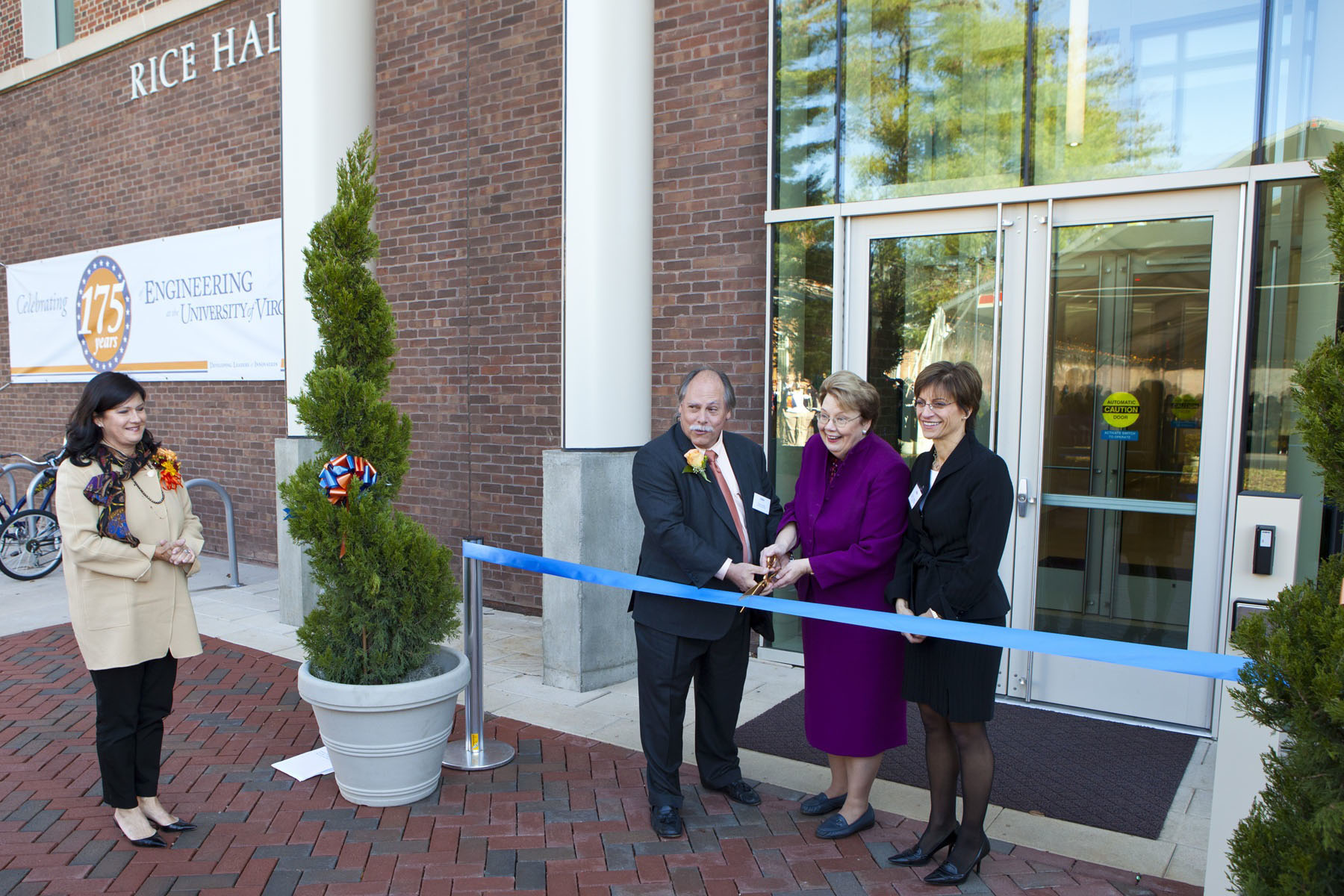The task of designing the University of Virginia's newest science and technology building was nothing if not daunting, said Paul Rice, namesake of Rice Hall, at its dedication on Friday: "Conceive a facility that is forward-looking and technologically inspiring at one of the most architecturally stunning places in the world."
And build it with engineers looking over your shoulder.
"Piece of cake," he said.
The six-story, 100,000-square-foot, $65.5 million building – the newest addition to the School of Engineering and Applied Science – was the star attraction at Friday's ceremony, attended by hundreds of engineering benefactors, supporters, faculty and students on a cold but sunny morning. After a ribbon-cutting and reception, scientist and inventor Dean Kamen spoke in the handsome new Olsson Auditorium.
The opening of the Rice Hall Information Technology Engineering Building coincided with the 175th anniversary of the U.Va. Engineering School. The building serves collaborative researchers as the nexus of information technology engineering at U.Va. It facilitates research and learning in areas that include high-performance computing, computer visualization, computer security, energy conservation, wireless communications, telemedicine, virtual reality, distributed multimedia and distance learning. The building also is home to the Computer Science Department and the computer engineering program.
The building was designed by Bohlin Cynwinski Jackson of Pittsburgh, which also designed the flagship Apple store on New York City's Fifth Avenue, and built by W.M. Jordan Company of Richmond.
Rice, a 1975 graduate in electrical engineering, and his wife Gina made the lead gift of $10 million through the Rice Family Foundation. He said in his remarks that he was delighted to see the Lacy Engineering Lab buzzing with students collaborating on robots for a competition that would take place Monday. "They had robots racing around, shooting baskets, shinnying up ropes," he said. "No one does anything by themselves anymore."
"This is the 21st-century version of the Academical Village," Dean James H. Aylor said during his dedication remarks. "Thomas Jefferson wanted buildings to teach."
And Rice Hall is a teaching tool, he explained. Students and faculty can monitor its advanced operating systems, such as heat, air conditioning and energy consumption, and conduct experiments to improve performance. Trane, a manufacturer of home and commercial heating and air conditioning systems, was a lead partner in the development of this "living lab."
That kind of education in science, technology, engineering and mathematics – the STEM fields – is of vital importance, Aylor said. "It's increasingly a STEM world," he said, adding that even "Sesame Street" is incorporating STEM lessons into its 42nd season.
U.Va. President Teresa A. Sullivan noted that Rice Hall broke ground in 2009, along with the neighboring Physical and Life Sciences Building, dedicated last month by the College of Arts & Sciences.
Both buildings will "strengthen our research programs, particularly the sciences, which was a priority of the Commission on the Future of the University," she said. "Colleges and universities have an excellent opportunity to offer solutions to the problems we are facing. The research done in Rice Hall is the kind of work that affects people in their daily lives."
The building also received support from individual donors, corporations, foundations, the University of Virginia and the Commonwealth of Virginia. "With the state's support, we are able to increase access to higher education for Virginians, especially in STEM disciplines," Sullivan said.
Few people are happier about Rice Hall than engineering students, who hosted poster exhibitions, did demonstrations and answered questions during Friday's celebration. They like the fact that wherever they turn, they can find a writing surface – including windows and cabinet doors – where they can collaborate and sketch out ideas.
"We have windows!" said Yousef Shakhsheer, a graduate student in electrical engineering. "When we were in Thornton Hall, we would go in when it was dark and go home when it was dark. The windows make a difference."
Tanima Dey, a graduate student in computer science, said the new labs and offices allow students to work together more closely. "It's easier for us to interact and exchange ideas," she said. Grad student Shanshan Chen said, "It's much quieter – it helps us concentrate."
And that's the goal, Aylor said. "Ideas will fly. Collaboration will grow. Anything will be possible," he said.
Media Contact
Article Information
November 19, 2011
/content/technologically-inspiring-rice-hall-dedicated

